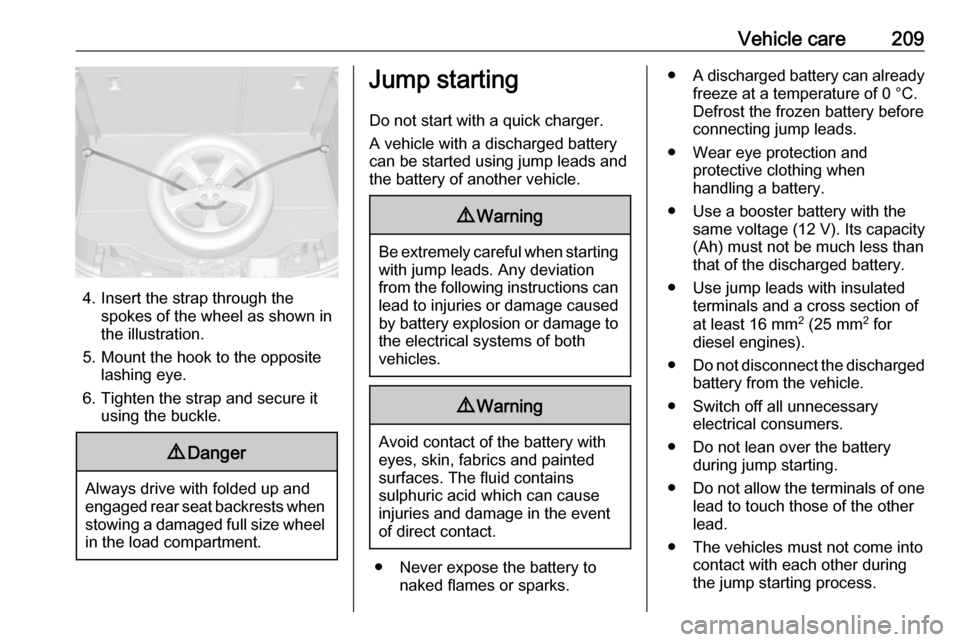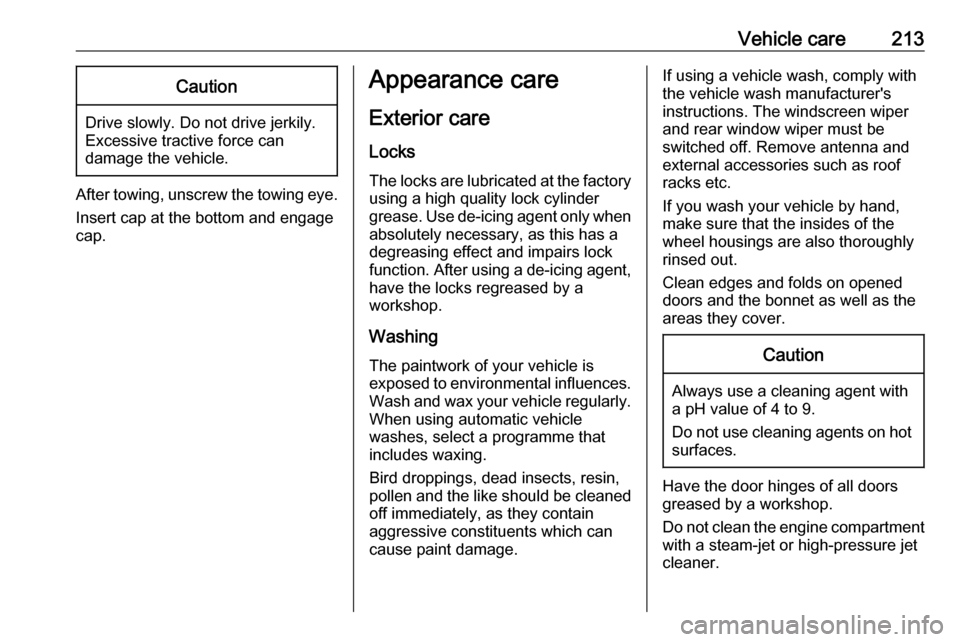wheel OPEL MOKKA X 2019.5 Manual user
[x] Cancel search | Manufacturer: OPEL, Model Year: 2019.5, Model line: MOKKA X, Model: OPEL MOKKA X 2019.5Pages: 247, PDF Size: 6.86 MB
Page 210 of 247

208Vehicle care
Attach wheel wrench and with the
jack correctly aligned rotate wheel wrench until wheel is clear of the
ground.
5. Unscrew the wheel nuts. 6. Change the wheel. Spare wheel 3 206.
7. Screw on the wheel nuts.
8. Lower the vehicle and remove jack.
9. Install the wheel wrench ensuring that it locates securely and tighten
each nut in a crosswise
sequence. Tightening torque is
140 Nm.
10. Align the valve hole in the wheel cover with the tyre valve before
installing.
Install wheel nut caps.
Install centre cap on alloy wheels.
11. Install vehicle jacking point cover on versions with sill panels.
12. Stow the replaced wheel 3 206
and the vehicle tools 3 194.
13. Check the tyre pressure of the installed tyre and the wheel nut
torque as soon as possible.
Have the defective tyre renewed or
repaired as soon as possible.
Stowing a damaged full size
wheel in the load compartment
The spare wheel well is not designed for other tyre sizes than the spare
wheel.
A damaged full size wheel must be stowed in the load compartment and
secured with a strap.
Vehicle tools 3 194.
To secure the wheel: 1. Position the wheel in the middle of
the load compartment.
2. Place the loop end of the strap through the lashing eye on one
side.
3. Place the hook end of the strap through the loop and pull it until
the strap is fastened securely to
the lashing eye.
Page 211 of 247

Vehicle care209
4. Insert the strap through thespokes of the wheel as shown in
the illustration.
5. Mount the hook to the opposite lashing eye.
6. Tighten the strap and secure it using the buckle.
9 Danger
Always drive with folded up and
engaged rear seat backrests when stowing a damaged full size wheel
in the load compartment.
Jump starting
Do not start with a quick charger.
A vehicle with a discharged battery
can be started using jump leads and the battery of another vehicle.9 Warning
Be extremely careful when starting
with jump leads. Any deviation
from the following instructions can
lead to injuries or damage caused
by battery explosion or damage to the electrical systems of both
vehicles.
9 Warning
Avoid contact of the battery with
eyes, skin, fabrics and painted
surfaces. The fluid contains
sulphuric acid which can cause
injuries and damage in the event
of direct contact.
● Never expose the battery to naked flames or sparks.
●A discharged battery can already
freeze at a temperature of 0 °C.
Defrost the frozen battery before
connecting jump leads.
● Wear eye protection and protective clothing when
handling a battery.
● Use a booster battery with the same voltage (12 V). Its capacity
(Ah) must not be much less than
that of the discharged battery.
● Use jump leads with insulated terminals and a cross section of
at least 16 mm 2
(25 mm 2
for
diesel engines).
● Do not disconnect the discharged
battery from the vehicle.
● Switch off all unnecessary electrical consumers.
● Do not lean over the battery during jump starting.
● Do not allow the terminals of one
lead to touch those of the other
lead.
● The vehicles must not come into contact with each other during
the jump starting process.
Page 213 of 247

Vehicle care211Towing
Towing the vehicle
Wrap a cloth around the tip of a flat
screwdriver to prevent paint damage.
Insert the screwdriver in the slot at the
lower part of the cap. Release the cap by carefully moving the screwdriver
downwards.
The towing eye is stowed with the
vehicle tools 3 194.
Screw in the towing eye as far as it will
go until it stops in a horizontal
position.
Attach a tow rope – or better still a tow
rod – to the towing eye.
The towing eye must only be used for
towing and not for recovering the
vehicle.
Switch on ignition to release steering wheel lock and to permit operation of
brake lights, horn and windscreen
wiper.
Switch the selector lever to neutral.
Release the parking brake.
Caution
Never tow a vehicle equipped with All Wheel Drive (AWD) with the
front or rear tyres on the road. If
you tow a vehicle equipped with
AWD while the front or rear tyres
are rolling on the road, the drive
system in the vehicle could be
severely damaged. When towing
vehicles equipped with AWD, all
four tyres must not be in contact
with the road.
Caution
Drive slowly. Do not drive jerkily.
Excessive tractive force can
damage the vehicle.
When the engine is not running,
considerably more force is needed to
brake and steer.
To prevent the entry of exhaust gases from the towing vehicle, switch on the
air recirculation system 3 123 and
close the windows.
Page 214 of 247

212Vehicle careVehicles with manual transmission:
The vehicle must be towed facing
forwards. The maximum speed is
80 km/h . In all other cases, and when
the transmission is defective, the front axle must be raised off the ground.
Vehicles with automatic transmission: Do not tow the vehicle using a towingeye. Towing with a tow rope could
cause severe automatic transmission
damage. When towing vehicles with
automatic transmission, use flat bed or wheel lift equipment.
Seek the assistance of a workshop.
After towing, unscrew the towing eye.
Insert cap and close cap.Towing another vehicle
Wrap a cloth around the tip of a flat
screwdriver to prevent paint damage. Insert the screwdriver in the slot at the
lower bend of the cap. Release the
cap by carefully moving the
screwdriver downwards.
The towing eye is stowed with the
vehicle tools 3 194.
Screw in the towing eye as far as it will
go until it stops in a horizontal
position.
The lashing eye at the rear
underneath the vehicle must never be used as a towing eye.
Attach a tow rope – or even better a
tow bar – to the towing eye.
The towing eye must only be used for
towing and not for recovering a
vehicle.
Page 215 of 247

Vehicle care213Caution
Drive slowly. Do not drive jerkily.
Excessive tractive force can
damage the vehicle.
After towing, unscrew the towing eye.
Insert cap at the bottom and engage
cap.
Appearance care
Exterior care
Locks The locks are lubricated at the factoryusing a high quality lock cylinder
grease. Use de-icing agent only when
absolutely necessary, as this has a
degreasing effect and impairs lock function. After using a de-icing agent, have the locks regreased by a
workshop.
Washing The paintwork of your vehicle is
exposed to environmental influences. Wash and wax your vehicle regularly.
When using automatic vehicle
washes, select a programme that
includes waxing.
Bird droppings, dead insects, resin,
pollen and the like should be cleaned
off immediately, as they contain
aggressive constituents which can
cause paint damage.If using a vehicle wash, comply with
the vehicle wash manufacturer's
instructions. The windscreen wiper
and rear window wiper must be
switched off. Remove antenna and
external accessories such as roof
racks etc.
If you wash your vehicle by hand,
make sure that the insides of the
wheel housings are also thoroughly
rinsed out.
Clean edges and folds on opened
doors and the bonnet as well as the
areas they cover.Caution
Always use a cleaning agent with
a pH value of 4 to 9.
Do not use cleaning agents on hot surfaces.
Have the door hinges of all doors
greased by a workshop.
Do not clean the engine compartment with a steam-jet or high-pressure jet
cleaner.
Page 216 of 247

214Vehicle careThoroughly rinse and leather-off the
vehicle. Rinse leather frequently. Use
separate leathers for painted and
glass surfaces: remnants of wax on
the windows will impair vision.
Do not use hard objects to remove spots of tar. Use tar removal spray on painted surfaces.
Exterior lights
Headlight and other light covers are made of plastic. Do not use any
abrasive or caustic agents, do not use
an ice scraper, and do not clean them
dry.
Polishing and waxing
Wax the vehicle regularly (at the
latest when water no longer beads).
Otherwise, the paintwork will dry out.
Polishing is necessary only if the paint
has become dull or if solid deposits
have become attached to it.
Paintwork polish with silicone forms a
protective film, making waxing
unnecessary.
Plastic body parts must not be treated with wax or polishing agents.Windows and windscreen wiper
blades
Switch off wipers before handling in
their areas.
Use a soft lint-free cloth or chamois leather together with window cleanerand insect remover.
When cleaning the rear window from
inside, always wipe in parallel to the
heating element to prevent damage.
For mechanical removal of ice, use a
sharp-edged ice scraper. Press the
scraper firmly against the glass so
that no dirt can get under it and
scratch the glass.
Clean smearing wiper blades with a
soft cloth and window cleaner.
Remove dirt residues from smearing
wiper blades by using a soft cloth and window cleaner. Also make sure to
remove any residues such as wax,
insect residues and similar from the
window.
Ice residues, pollution and continuous
wiping on dry windows will damage or
even destroy the wiper blades.Wheels and tyres
Do not use high-pressure jet
cleaners.
Clean rims with a pH-neutral wheel
cleaner.
Rims are painted and can be treated
with the same agents as the body.
Paintwork damageRectify minor paintwork damage with
a touch-up pen before rust forms.
Have more extensive damage or rust
areas repaired by a workshop.
Underbody Some areas of the vehicle underbody
have a PVC undercoating while other
critical areas have a durable
protective wax coating.
After the underbody is washed, check
the underbody and have it waxed if
necessary.
Bitumen / rubber materials could damage the PVC coating. Have
underbody work carried out by a
workshop.
Page 228 of 247
![OPEL MOKKA X 2019.5 Manual user 226Technical dataPerformanceEngineD14NETD14NELA18XERMaximum speed [km/h]Manual transmission196/1863)185180Automatic transmission191–1803)
Vehicles with All-wheel drive system.EngineD16DTID16DTHMaxim OPEL MOKKA X 2019.5 Manual user 226Technical dataPerformanceEngineD14NETD14NELA18XERMaximum speed [km/h]Manual transmission196/1863)185180Automatic transmission191–1803)
Vehicles with All-wheel drive system.EngineD16DTID16DTHMaxim](/img/37/18898/w960_18898-227.png)
226Technical dataPerformanceEngineD14NETD14NELA18XERMaximum speed [km/h]Manual transmission196/1863)185180Automatic transmission191–1803)
Vehicles with All-wheel drive system.EngineD16DTID16DTHMaximum speed [km/h]Manual transmission178190/187 3)Automatic transmission–1883)
Vehicles with All-wheel drive system.
Page 229 of 247
![OPEL MOKKA X 2019.5 Manual user Technical data227Vehicle weightKerb weight, basic model without any optional equipmentEngineManual transmissionAutomatic transmission[kg]D14NET1394/1445 4)1409D14NEL1394–A18XER13801467D16DTI1474–D OPEL MOKKA X 2019.5 Manual user Technical data227Vehicle weightKerb weight, basic model without any optional equipmentEngineManual transmissionAutomatic transmission[kg]D14NET1394/1445 4)1409D14NEL1394–A18XER13801467D16DTI1474–D](/img/37/18898/w960_18898-228.png)
Technical data227Vehicle weightKerb weight, basic model without any optional equipmentEngineManual transmissionAutomatic transmission[kg]D14NET1394/1445 4)1409D14NEL1394–A18XER13801467D16DTI1474–D16DTH1374/1529 4)14874)
Vehicles with All-wheel drive system.
Optional equipment and accessories increase the kerb weight.
Loading information 3 74.
Page 230 of 247
![OPEL MOKKA X 2019.5 Manual user 228Technical dataVehicle dimensionsLength [mm]4275Width without exterior mirrors [mm]1781Width with two exterior mirrors [mm]2038Height (without antenna) [mm]1659/17465)Length of load compartment floo OPEL MOKKA X 2019.5 Manual user 228Technical dataVehicle dimensionsLength [mm]4275Width without exterior mirrors [mm]1781Width with two exterior mirrors [mm]2038Height (without antenna) [mm]1659/17465)Length of load compartment floo](/img/37/18898/w960_18898-229.png)
228Technical dataVehicle dimensionsLength [mm]4275Width without exterior mirrors [mm]1781Width with two exterior mirrors [mm]2038Height (without antenna) [mm]1659/17465)Length of load compartment floor [mm]731Length of load compartment with folded rear seats [mm]1428Load compartment width [mm]914Load compartment height [mm]808Wheelbase [mm]2555Turning circle diameter [m]10.9/11.3 5)5)
Depending on wheel size and equipment.
Page 232 of 247
![OPEL MOKKA X 2019.5 Manual user 230Technical dataTyre pressuresComfort with up to 3 peopleECO with up to 3 peopleWith full loadEngineTyresfrontrearfrontrearfrontrear[kPa/bar]
([psi])[kPa/bar]
([psi])[kPa/bar]
([psi])[kPa/bar]
([psi] OPEL MOKKA X 2019.5 Manual user 230Technical dataTyre pressuresComfort with up to 3 peopleECO with up to 3 peopleWith full loadEngineTyresfrontrearfrontrearfrontrear[kPa/bar]
([psi])[kPa/bar]
([psi])[kPa/bar]
([psi])[kPa/bar]
([psi]](/img/37/18898/w960_18898-231.png)
230Technical dataTyre pressuresComfort with up to 3 peopleECO with up to 3 peopleWith full loadEngineTyresfrontrearfrontrearfrontrear[kPa/bar]
([psi])[kPa/bar]
([psi])[kPa/bar]
([psi])[kPa/bar]
([psi])[kPa/bar]
([psi])[kPa/bar]
([psi])D14NET,
D14NEL ,
A18XER215/60 R17,220/2.2 (32)220/2.2 (32)270/2.7 (39)280/2.8 (41)270/2.7 (39)300/3.0 (44)215/55 R18215/65 R16200/2.0 (29)200/2.0 (29)270/2.7 (39)280/2.8 (41)270/2.7 (39)300/3.0 (44)225/45 R19240/2.4 (35)240/2.4 (35)270/2.7 (39)280/2.8 (41)270/2.7 (39)280/2.8 (41)D16DTI,
D16DTH215/60R17,240/2.4 (35)240/2.4 (35)270/2.7 (39)280/2.8 (41)270/2.7 (39)300/3.0 (44)215/55 R18215/65 R16220/2.2 (32)220/2.2 (32)270/2.7 (39)280/2.8 (41)270/2.7 (39)300/3.0 (44)225/45 R19240/2.4 (35)240/2.4 (35)270/2.7 (39)280/2.8 (41)270/2.7 (39)280/2.8 (41)AllTemporary spare
wheel
125/70 R16420/4.2 (60)420/4.2 (60)––420/4.2 (60)420/4.2 (60)
For countries outside the European Union, the tyre pressure is independent of the tyre load.